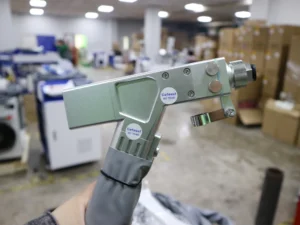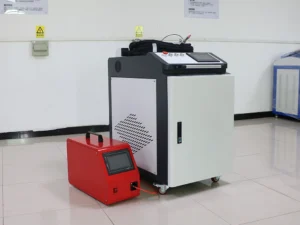Introduction:
Laser welding is a precise, efficient welding process using a high-energy laser beam to join materials. It offers several advantages over traditional welding methods, including high welding speeds, minimal heat-affected zone, precise control, and the ability to weld various materials. Here’s what you need to know about laser welding machine.
How does a laser welding machine work?
Laser welding focuses a concentrated beam of light from a laser source onto the workpiece. The intense heat of the laser beam melts the material’s surface, and as the beam moves along the seam, the molten material solidifies, forming a weld.
Types of laser welding machines
There are many types of laser welding machines to choose from, including:
1. CO2 laser
These machines use carbon dioxide gas to create a laser beam. They are typically used to weld thicker materials such as metals and plastics.
2. YAG laser
YAG (Neodymium-doped Yttrium Aluminum Garnet) lasers are solid-state lasers that emit light at near-infrared wavelengths. They are suitable for precision welding of metals and some plastics.
3. Fiber laser
Fiber lasers use optical fibers to deliver the laser beam. They are efficient and provide excellent beam quality for various welding applications.

Weldable materials
Laser welding can join a wide variety of materials, including metals such as steel, aluminum, copper, titanium, and their alloys. It can also weld certain plastics and other materials using proper laser parameters and techniques.
Advantages of laser welding machine
Compared with traditional welding methods, laser welding has the following advantages:
1. Precise control
Laser welding allows precise control of the welding process, resulting in precise and repeatable welds.
2. Minimal thermal deformation
The focused laser beam creates a small heat-affected zone, reducing the risk of deformation or damage to surrounding materials.
3. High welding speed
Laser welding is a high-speed process that increases productivity and efficiency.

4. Versatility
Laser welding can weld a wide variety of materials and thicknesses, making it suitable for a variety of applications.
5. Application of laser welding
Laser welding is widely used in automotive, aerospace, electronics, medical device manufacturing, jewelry, and other industries. It is used for welding parts, joints, seams, and complex assemblies.
6. Security considerations
Laser welding involves high-energy laser beams, so proper safety precautions must be taken. Operators should wear safety glasses, follow safety guidelines, and ensure the workplace is well-ventilated.
In addition, another critical factor is power. These machines come in various power levels, from low to high. The power you need depends on the thickness and type of metal you plan to weld. Therefore, it is crucial to consider the materials you will be working with to ensure you have the right machine for the job.
It’s worth noting that laser welding machines vary in capabilities, power levels, and features. Following these security considerations will help minimize risks and ensure the safe operation of laser welding machines.
